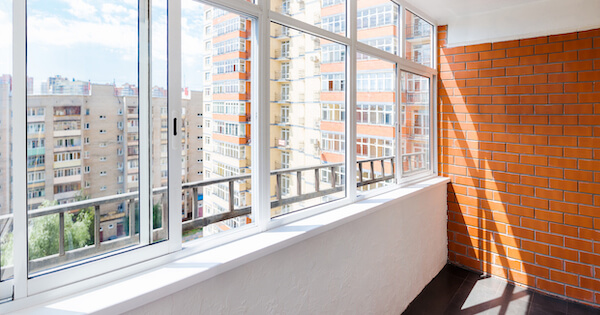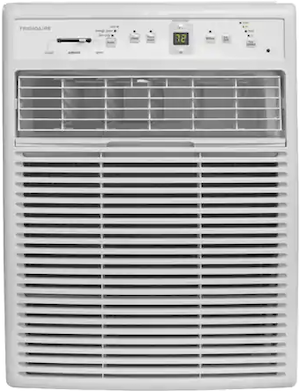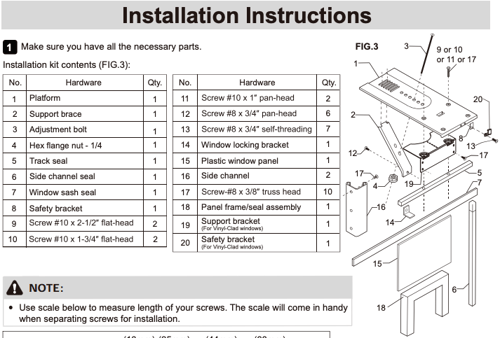
Crank out windows can be a bummer when the summer heat hits. Also referred to as "slider" windows and "casement" windows, the common window air conditioner won't work here. Typical window air conditioners are wider than they are tall, and they won't fit into a casement window. And unfortunately you can't just tip a normal AC unit on its side for use in a narrower window.
Dealing with crank out windows can definitely be a hassle. Even if a typical window air conditioner will fit into a slider window gap, you'll need to DIY a support system to keep it in place - and there are plenty of DIY projects online of people doing this!
There are a limited number of casement air conditioners available, so you'll have to compare the cost (both the upfront cost as well as the time and energy of installing it) against using a portable air conditioner instead! (For more information on ACs, check out our air conditioner buying guide.)
Table of Contents
- Product Review: Frigidaire FFRS0822S1
- Installing a Casement AC
- Casement vs Portable Air Conditioners
- Alternatives to Casement Units
Casement Window Air Conditioner Reviews
Frigidaire offers two casement air conditioner models: an 8,000 BTU model (ideal for around 250-350 square feet) and a 10,000 BTU model (ideal for around 350-450 square feet). Read more about choosing the right air conditioner size here. The models both offer the same basic control panel and remote control, so we'll focus on the 8,000 BTU model.
Other brands offering casement air conditioners include:
-
Arctic King (owned by Midea)
-
Koldfront (owned by Living Direct Inc)
-
Midea
-
Perfect Aire (American-based, est. in 2009)
The Frigidaire FFRS0822S1 retails at $599. It comes with a one year parts and labor warranty plus five years on the sealed system. The operation noise is pretty good, just 48.4 dB on low power, up to 55.1 dB on high. The average conversation takes place at 60 decibels, and the lower power noise will sound about half as loud as a conversation (a change of 10 decibels sounds like a "doubling" of volume).
This casement air conditioner has simple push-button controls. Options include modes for Sleep and Energy Saver. Energy Saver mode runs the fan intermittently after the set temperature has been reached, so the compressor only turns back on when the room temperature rises. Sleep mode raises the temperature by 2 °F after 30 minutes and then another 2 °F after another 30 minutes. These small adjustments can really help reduce the energy usage of the air conditioner while also allowing you to sleep comfortably if the unit is in a bedroom. The model also comes with a basic 24-hour programmable on/off timer function so you can set the unit to start or stop after anywhere from 1 to 24 hours has passed.
It has an Energy Efficiency Ratio of 10.8, which isn't terrible, although the most efficient 8,000 BTU units typically have ratios of 12.0 or more (the higher the number, the more efficient the unit). It comes with a 6' power cord and a remote, and it weighs 79 pounds.
The 10,000 BTU model, the Frigidaire FFRS1022R1, retails at $649. It has the same exterior dimensions and feature set. It's a bit louder: 58 dB on low and 61 dB on high, so it may be a bit disruptive if you try to socialize or watch TV nearby.
Dimensions:
-
Window Width: 15.5"
-
Height: 20.25"
-
Width: 14.2"
-
Depth: 23.5"
Compatible With the Following Window Dimensions:
-
Minimum Width: 15.5"
-
Maximum Width (for casement windows): 16.25"
-
Minimum Height: 21.5" with window panel retainer, or as low as 20.31" with the retainer removed
-
Maximum Height: 40"
Click here to read over 115 real customer reviews of the 8,000 BTU Frigidaire FFRS0822S1!
Frigidaire FFRS0822S1 - MSRP $599 - CLICK HERE FOR CURRENT PRICING

Installing a Casement Air Conditioner
Installing these models can be tricky. Although this isn't a full tutorial by any means, we wanted to give you an idea of what to expect when installing a casement air conditioner.
If you've ordered your casement AC online and had it delivered, it might have spent some time on its side, so the fluids may have sloshed around a bit. Let it sit upright for 12-24 hours before you install it.
The Frigidaire casement air conditioners require the following to be installed:
-
Flat-head and Phillips-head screwdrivers, a carpenter's level, a fine tooth saw, a drill, a knife and scissors, a tape measure, and a pencil.
-
Additionally, for wood-frame casement windows, you may need to construct a frame with a 15.5" wide opening, using 1" thick wood.
-
For brick/cement buildings, you may need to put a strip of wood under the air conditioner.
The unit comes with a full installation kit to suit different window heights and widths, and is designed to work with wood slide-by sash or metal casement windows. Additional steps can be taken to install it in vinyl-clad windows. You'll have to assemble and install a platform into the window sill that braces against the exterior wall as well as cut and install a cover to fill the remaining gap between the casement air conditioner and the top of the window frame.
Although installing a typical window air conditioner isn't a fun job, installing a casement model is definitely more complex! Your local appliance store may offer installation if you find this project daunting.
Just look at all of those parts!

(From Frigidaire installation manual 2020213A1659)
Casement ACs vs Portable ACs
Are you considering a casement AC vs a portable air conditioner? Here are the advantages and disadvantages of each, as we see them:
-
Both require some additional installation effort to block off the rest of the window and insulate it. You can DIY a portable air conditioner installation with less equipment and without drilling holes, however.
-
Portable air conditioners are more widely available - they're easy to find and there are a lot of different models and BTU ratings. And when it comes to 8,000-10,000 BTU models, they can be 30-50% cheaper than the casement air conditioners we reviewed above. However, their actual performance is more like 4,000-6,000 BTUs. To get the performance of an 8,000 BTU window air conditioner, you'll need a 13,000+ BTU portable model.
-
This is because portable units are worse at cooling than window air conditioners, so portable units sacrifice performance and will cost more to run.
-
There are two types of BTU ratings on portable ACs! Pay attention to the "DOE BTU" rating rather than the plain "BTU" rating on a portable model. The DOE BTU rating is a newer standard that takes into account the waste heat that the portable unit generates, and is easily 30-40% lower than the regular BTU rating.
-
Read more about portable vs window ACs here.
Casement Air Conditioner Alternatives
If you're not set on a casement window air conditioner, here are a few other choices:
-
Again, portable air conditioners are an option, although they aren't ideal.
-
If the window is wide enough to fit a normal window air conditioner unit, a DIY installation with a support frame is possible, but not recommended (especially if you're renting).
-
A ductless mini split could be a good option if you are considering a permanent install. This type of air conditioner requires a small hole to be cut in the wall, but it's not nearly as extensive as central air ductwork. Some mini splits can heat and cool so they can pull double duty as supplemental heating in the winter.
-
Through-the-wall air conditioners are also an option. They tend to be noisier and less efficient than mini splits, but they are cheaper.
- There's always central air if you have the space and existing ductwork that's in good condition.
There is no one perfect option, unfortunately! Each alternative has downsides.
We hope this helped you figure out your options with casement window air conditioners. Let us know if you have any questions. Leave us a comment below - We'd love to hear from you!
Editor's Note: This blog was originally written in March of 2020 and has been completely revamped and updated for accuracy as of the publication date noted above.





